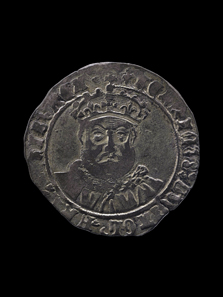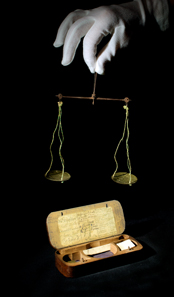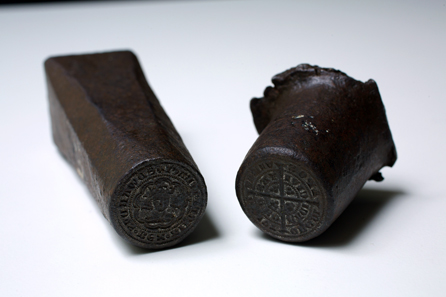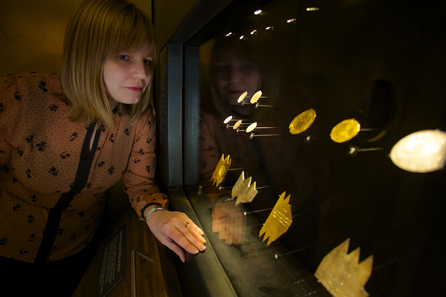June 13, 2013 – Historic Royal Palaces in partnership with the Royal Mint Museum has launched on May 24, 2013 a new permanent exhibition at the Tower of London. Located on the historic site that was once the country’s Mint for over 500 years (c1279-1812), ‘Coins and Kings: The Royal Mint at the Tower’, will explore the long history of this institution and its connection to London’s premier fortress.
Henry VIII debased Testoon. Debased silver Testoon featuring a ‘Holbein-style’ portrait of Henry VIII. Many of Henry VIII’s debased silver coins actually contained more cheap metal, such as copper, than silver. As the coins wore down the copper shone through the king’s image, earning him the nickname ‘Old Coppernose’. © Historic Royal Palaces.
Visitors will be able to explore five pivotal ‘moments’ from the history of the Mint, including Isaac Newton’s efforts to rid London of counterfeiters, when he was Warden of the Mint. Other stories will chart Edward I’s harsh punishments for people who tampered with his coins, Elizabeth I’s restoration of the coinage following her father Henry VIII’s disastrous meddling, and Charles II’s rejection of Commonwealth money.
Guinea scales, 1700-1850. By 1798, the Mint made high value gold coins such as guineas, but hardly any silver or copper coins. People often used portable scales, such as these, to check their coin was the correct weight and not a forgery. © Historic Royal Palaces.
Each moment will be represented by a key coin made at the Tower and the exhibition features rare objects from the Royal Mint Museum, amongst other lenders, as well as innovative digital and physical displays that will bring to life the stories of people and monarchs at the Mint in an area previously unopened to visitors.
Pair of iron dies for a half groat (2d). Dies like these from Edward III’s reign were used to make all medieval coins. An image was engraved into each die and hardened by heat. The die with the spike was set into a block, and a blank coin placed in-between the two dies. The top die was then hit with a hammer, which stamped the images onto the coin. © Historic Royal Palaces.
Star objects include a rare silver Edward I groat (1279-1307), Henry VIII gold trial plate (1542) …
In the 1660s, Thomas Simon, formerly Chief Engraver to Oliver Cromwell, was so determined to engrave Charles II’s currency that he sent the king one of these beautiful coins to demonstrate his skills. Yet, despite his efforts, Charles gave the job to Dutchman John Roettiers. Sadly, just three years later, Simon fell victim to the plague and died. On the right: Charles’ image was painstakingly engraved onto this ‘portrait punch’. It was used as the master tool so that identical dies could be made quickly for use in the new screw presses. © Historic Royal Palaces.
… and a Charles II petition crown (1663); a coin that was never actually in circulation but was designed by Thomas Simon, formerly Chief Engraver to Oliver Cromwell. Simon was so determined to engrave Charles II’s currency that he sent the king one of these beautiful coins to demonstrate his skills. Yet, despite his efforts, Charles gave the job to Dutchman John Roettiers. Sadly, just three years later, Simon fell victim to the plague and died.
Dr Megan Gooch looks at a case of rare coins at the launch of the new exhibition. © Historic Royal Palaces.
Megan Gooch, Curator at Historic Royal Palaces, said: ‘The Tower is widely known as a palace and a prison, and of course the home of the Crown Jewels, but it was also a hive of industry and The Mint was one of these industries, where most of the nation’s coins were made for over 500 years.
We wanted to tell the important stories of the Mint, and to show what impact it had on the country’s currency and how big political events affected how coins, as well as which coins, were made.
In the exhibition we tell these stories through key moments in the Mint’s history, exploring the lives of the people who lived and worked there and the actions of the monarchs whose portraits graced every coin made at the Mint.’
Dr Kevin Clancy, Director of the Royal Mint Museum, said: ‘For the first time we can tell the story of the history of The Royal Mint, where it happened on Mint Street. It is a wonderful opportunity for visitors to the Tower to see items from the Royal Mint Museum’s outstanding collection, and to engage with the history of the Mint in the Tower in an entertaining way’.
More information on this exhibition offer The Royal Mint Museum …
… and The Tower of London website.









